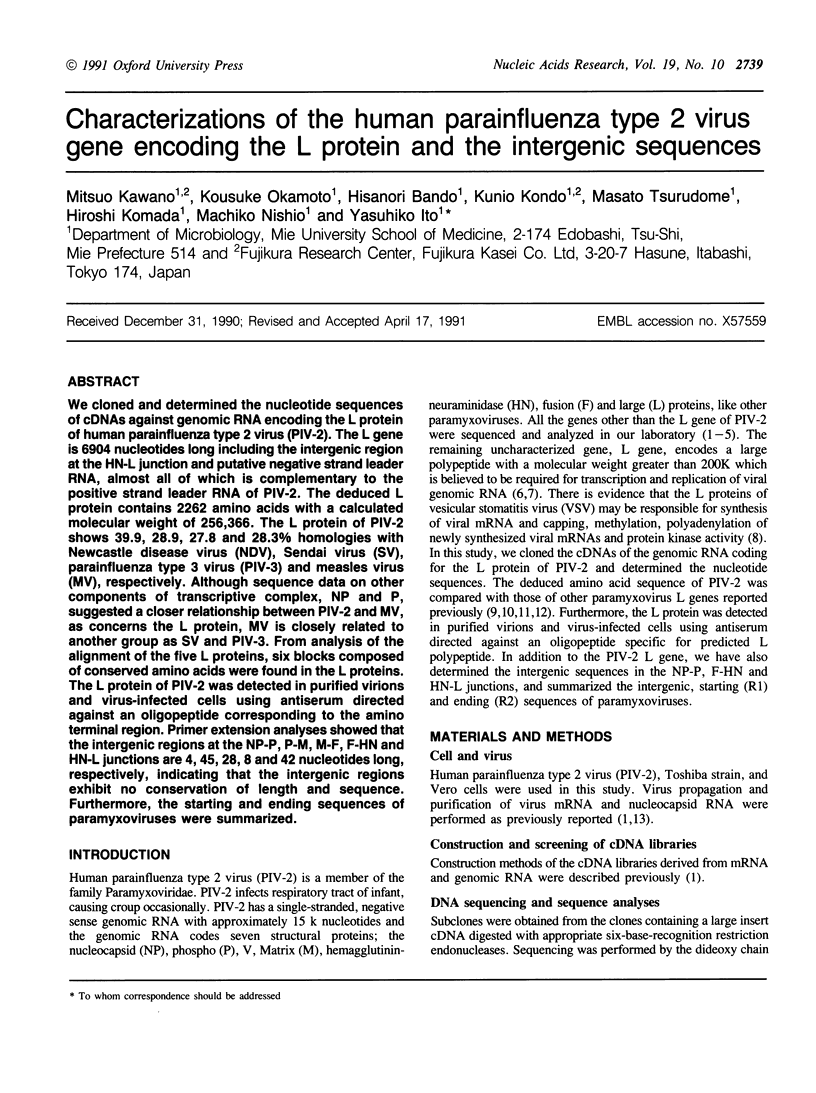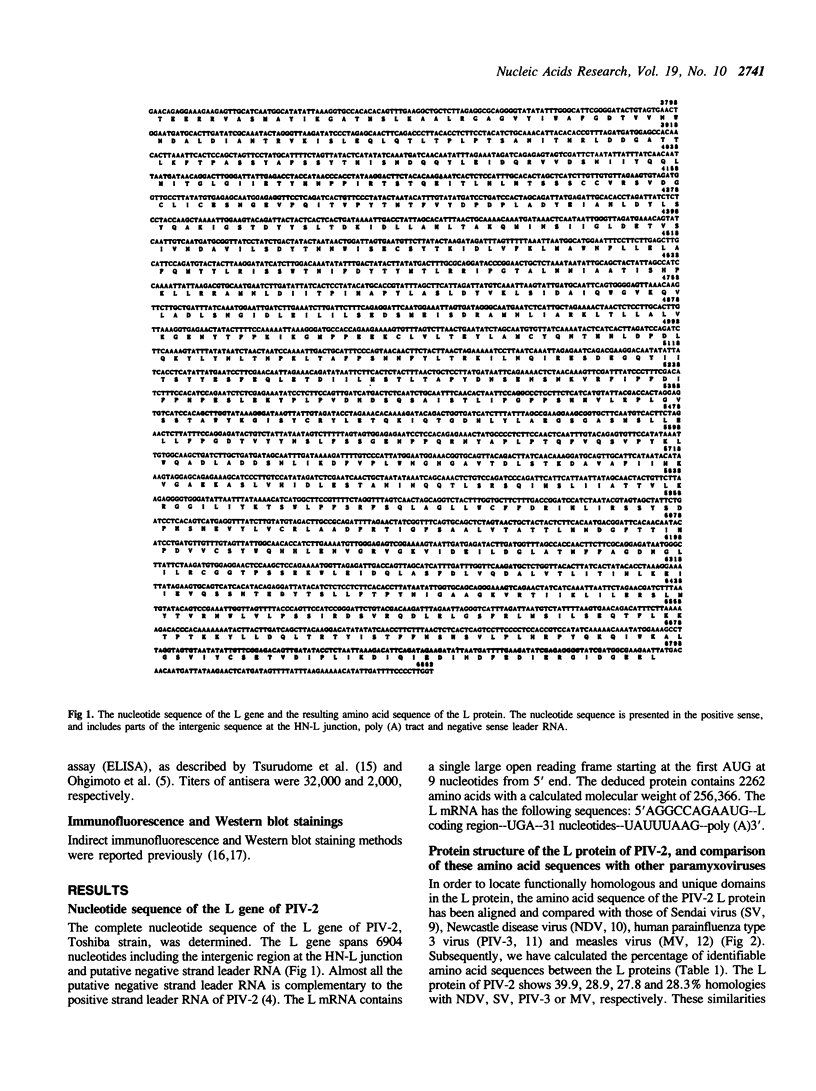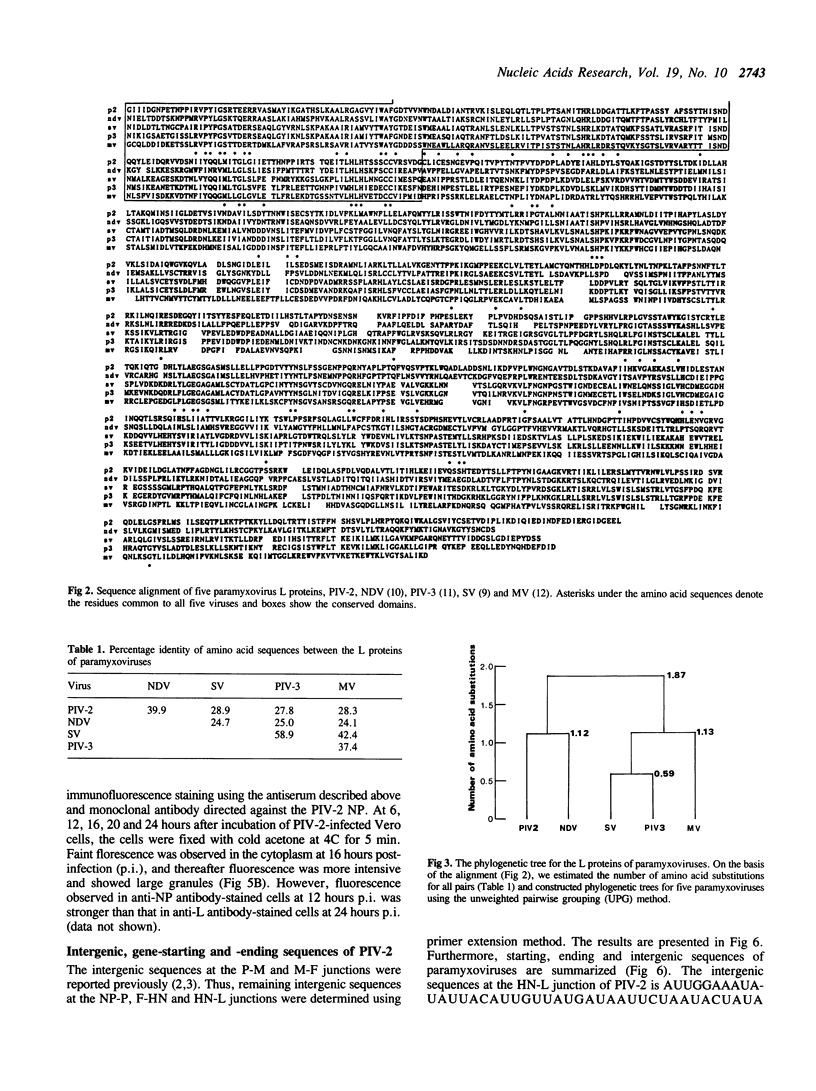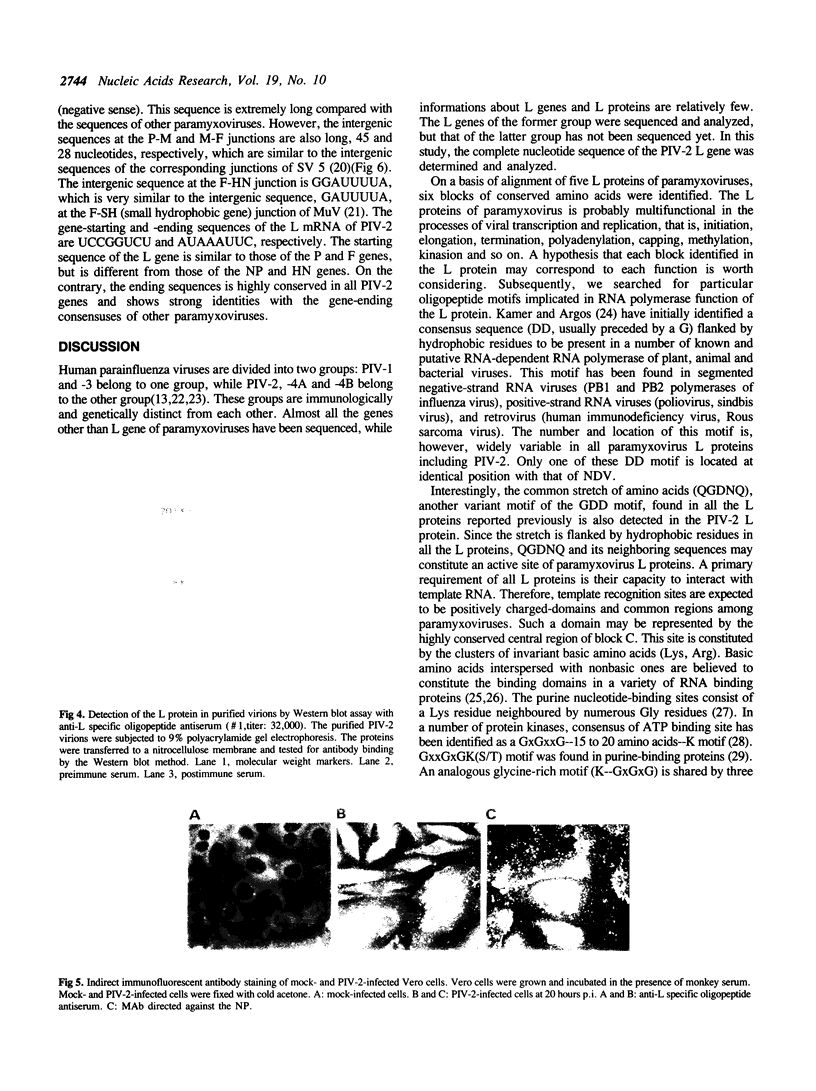Abstract
We cloned and determined the nucleotide sequences of cDNAs against genomic RNA encoding the L protein of human parainfluenza type 2 virus (PIV-2). The L gene is 6904 nucleotides long including the intergenic region at the HN-L junction and putative negative strand leader RNA, almost all of which is complementary to the positive strand leader RNA of PIV-2. The deduced L protein contains 2262 amino acids with a calculated molecular weight of 256,366. The L protein of PIV-2 shows 39.9, 28.9, 27.8 and 28.3% homologies with Newcastle disease virus (NDV), Sendai virus (SV), parainfluenza type 3 virus (PIV-3) and measles virus (MV), respectively. Although sequence data on other components of transcriptive complex, NP and P, suggested a closer relationship between PIV-2 and MV, as concerns the L protein, MV is closely related to another group as SV and PIV-3. From analysis of the alignment of the five l proteins, six blocks composed of conserved amino acids were found in the L proteins. The L protein of PIV-2 was detected in purified virions and virus-infected cells using antiserum directed against an oligopeptide corresponding to the amino terminal region. Primer extension analyses showed that the intergenic regions at the NP-P, P-M, M-F, F-HN and HN-L junctions are 4, 45, 28, 8 and 42 nucleotides long, respectively, indicating that the intergenic regions exhibit no conservation of length and sequence. Furthermore, the starting and ending sequences of paramyxoviruses were summarized.
Full text
PDF







Images in this article
Selected References
These references are in PubMed. This may not be the complete list of references from this article.
- Barik S., Rud E. W., Luk D., Banerjee A. K., Kang C. Y. Nucleotide sequence analysis of the L gene of vesicular stomatitis virus (New Jersey serotype): identification of conserved domains in L proteins of nonsegmented negative-strand RNA viruses. Virology. 1990 Mar;175(1):332–337. doi: 10.1016/0042-6822(90)90218-g. [DOI] [PubMed] [Google Scholar]
- Blumberg B. M., Crowley J. C., Silverman J. I., Menonna J., Cook S. D., Dowling P. C. Measles virus L protein evidences elements of ancestral RNA polymerase. Virology. 1988 Jun;164(2):487–497. doi: 10.1016/0042-6822(88)90563-6. [DOI] [PubMed] [Google Scholar]
- Crowley J. C., Dowling P. C., Menonna J., Silverman J. I., Schuback D., Cook S. D., Blumberg B. M. Sequence variability and function of measles virus 3' and 5' ends and intercistronic regions. Virology. 1988 Jun;164(2):498–506. doi: 10.1016/0042-6822(88)90564-8. [DOI] [PubMed] [Google Scholar]
- Elango N., Varsanyi T. M., Kövamees J., Norrby E. Molecular cloning and characterization of six genes, determination of gene order and intergenic sequences and leader sequence of mumps virus. J Gen Virol. 1988 Nov;69(Pt 11):2893–2900. doi: 10.1099/0022-1317-69-11-2893. [DOI] [PubMed] [Google Scholar]
- Galinski M. S., Mink M. A., Pons M. W. Molecular cloning and sequence analysis of the human parainfluenza 3 virus gene encoding the L protein. Virology. 1988 Aug;165(2):499–510. doi: 10.1016/0042-6822(88)90594-6. [DOI] [PubMed] [Google Scholar]
- Gorbalenia A. E., Blinov V. M., Kunin E. V. Predskazanie nukleotidsviazyvaiushchikh svoistv virusnykh belkov po ikh pervichnoi strukture. Mol Gen Mikrobiol Virusol. 1985 Nov;(11):30–36. [PubMed] [Google Scholar]
- Hamaguchi M., Yoshida T., Nishikawa K., Naruse H., Nagai Y. Transcriptive complex of Newcastle disease virus. I. Both L and P proteins are required to constitute an active complex. Virology. 1983 Jul 15;128(1):105–117. doi: 10.1016/0042-6822(83)90322-7. [DOI] [PubMed] [Google Scholar]
- Ito Y., Tsurudome M., Bando H., Komada H., Nishio M. Incomplete replication of human parainfluenza virus type 2 in mouse L929 cells. Arch Virol. 1989;108(1-2):137–144. doi: 10.1007/BF01313751. [DOI] [PubMed] [Google Scholar]
- Ito Y., Tsurudome M., Hishiyama M. The polypeptides of human parainfluenza type 2 virus and their synthesis in infected cells. Arch Virol. 1987;95(3-4):211–224. doi: 10.1007/BF01310781. [DOI] [PubMed] [Google Scholar]
- Kamer G., Argos P. Primary structural comparison of RNA-dependent polymerases from plant, animal and bacterial viruses. Nucleic Acids Res. 1984 Sep 25;12(18):7269–7282. doi: 10.1093/nar/12.18.7269. [DOI] [PMC free article] [PubMed] [Google Scholar]
- Kamps M. P., Taylor S. S., Sefton B. M. Direct evidence that oncogenic tyrosine kinases and cyclic AMP-dependent protein kinase have homologous ATP-binding sites. Nature. 1984 Aug 16;310(5978):589–592. doi: 10.1038/310589a0. [DOI] [PubMed] [Google Scholar]
- Kawano M., Bando H., Ohgimoto S., Kondo K., Tsurudome M., Nishio M., Ito Y. Sequence of the fusion protein gene of human parainfluenza type 2 virus and its 3' intergenic region: lack of small hydrophobic (SH) gene. Virology. 1990 Sep;178(1):289–292. doi: 10.1016/0042-6822(90)90406-h. [DOI] [PubMed] [Google Scholar]
- Kawano M., Bando H., Ohgimoto S., Okamoto K., Kondo K., Tsurudome M., Nishio M., Ito Y. Complete nucleotide sequence of the matrix gene of human parainfluenza type 2 virus and expression of the M protein in bacteria. Virology. 1990 Dec;179(2):857–861. doi: 10.1016/0042-6822(90)90155-k. [DOI] [PubMed] [Google Scholar]
- Kawano M., Bando H., Yuasa T., Kondo K., Tsurudome M., Komada H., Nishio M., Ito Y. Sequence determination of the hemagglutinin-neuraminidase (HN) gene of human parainfluenza type 2 virus and the construction of a phylogenetic tree for HN proteins of all the paramyxoviruses that are infectious to humans. Virology. 1990 Jan;174(1):308–313. doi: 10.1016/0042-6822(90)90081-2. [DOI] [PubMed] [Google Scholar]
- Kondo K., Bando H., Tsurudome M., Kawano M., Nishio M., Ito Y. Sequence analysis of the phosphoprotein (P) genes of human parainfluenza type 4A and 4B viruses and RNA editing at transcript of the P genes: the number of G residues added is imprecise. Virology. 1990 Sep;178(1):321–326. doi: 10.1016/0042-6822(90)90413-l. [DOI] [PubMed] [Google Scholar]
- Lazinski D., Grzadzielska E., Das A. Sequence-specific recognition of RNA hairpins by bacteriophage antiterminators requires a conserved arginine-rich motif. Cell. 1989 Oct 6;59(1):207–218. doi: 10.1016/0092-8674(89)90882-9. [DOI] [PubMed] [Google Scholar]
- Möller W., Amons R. Phosphate-binding sequences in nucleotide-binding proteins. FEBS Lett. 1985 Jul 1;186(1):1–7. doi: 10.1016/0014-5793(85)81326-0. [DOI] [PubMed] [Google Scholar]
- Ohgimoto S., Bando H., Kawano M., Okamoto K., Kondo K., Tsurudome M., Nishio M., Ito Y. Sequence analysis of P gene of human parainfluenza type 2 virus: P and cysteine-rich proteins are translated by two mRNAs that differ by two nontemplated G residues. Virology. 1990 Jul;177(1):116–123. doi: 10.1016/0042-6822(90)90465-4. [DOI] [PubMed] [Google Scholar]
- Poch O., Blumberg B. M., Bougueleret L., Tordo N. Sequence comparison of five polymerases (L proteins) of unsegmented negative-strand RNA viruses: theoretical assignment of functional domains. J Gen Virol. 1990 May;71(Pt 5):1153–1162. doi: 10.1099/0022-1317-71-5-1153. [DOI] [PubMed] [Google Scholar]
- Sanger F., Nicklen S., Coulson A. R. DNA sequencing with chain-terminating inhibitors. Proc Natl Acad Sci U S A. 1977 Dec;74(12):5463–5467. doi: 10.1073/pnas.74.12.5463. [DOI] [PMC free article] [PubMed] [Google Scholar]
- Schubert M., Harmison G. G., Meier E. Primary structure of the vesicular stomatitis virus polymerase (L) gene: evidence for a high frequency of mutations. J Virol. 1984 Aug;51(2):505–514. doi: 10.1128/jvi.51.2.505-514.1984. [DOI] [PMC free article] [PubMed] [Google Scholar]
- Sheshberadaran H., Lamb R. A. Sequence characterization of the membrane protein gene of paramyxovirus simian virus 5. Virology. 1990 May;176(1):234–243. doi: 10.1016/0042-6822(90)90248-p. [DOI] [PubMed] [Google Scholar]
- Shioda T., Iwasaki K., Shibuta H. Determination of the complete nucleotide sequence of the Sendai virus genome RNA and the predicted amino acid sequences of the F, HN and L proteins. Nucleic Acids Res. 1986 Feb 25;14(4):1545–1563. doi: 10.1093/nar/14.4.1545. [DOI] [PMC free article] [PubMed] [Google Scholar]
- Spriggs M. K., Collins P. L. Human parainfluenza virus type 3: messenger RNAs, polypeptide coding assignments, intergenic sequences, and genetic map. J Virol. 1986 Sep;59(3):646–654. doi: 10.1128/jvi.59.3.646-654.1986. [DOI] [PMC free article] [PubMed] [Google Scholar]
- Spriggs M. K., Johnson P. R., Collins P. L. Sequence analysis of the matrix protein gene of human parainfluenza virus type 3: extensive sequence homology among paramyxoviruses. J Gen Virol. 1987 May;68(Pt 5):1491–1497. doi: 10.1099/0022-1317-68-5-1491. [DOI] [PubMed] [Google Scholar]
- Tsurudome M., Nishio M., Komada H., Bando H., Ito Y. Extensive antigenic diversity among human parainfluenza type 2 virus isolates and immunological relationships among paramyxoviruses revealed by monoclonal antibodies. Virology. 1989 Jul;171(1):38–48. doi: 10.1016/0042-6822(89)90508-4. [DOI] [PubMed] [Google Scholar]
- Tsurudome M., Yamada A., Hishiyama M., Ito Y. Monoclonal antibodies against the glycoproteins of mumps virus: fusion inhibition by anti-HN monoclonal antibody. J Gen Virol. 1986 Oct;67(Pt 10):2259–2265. doi: 10.1099/0022-1317-67-10-2259. [DOI] [PubMed] [Google Scholar]
- Yuasa T., Bando H., Kawano M., Tsurudome M., Nishio M., Kondo K., Komada H., Ito Y. Sequence analyses of the 3' genome end and NP gene of human parainfluenza type 2 virus: sequence variation of the gene-starting signal and the conserved 3' end. Virology. 1990 Dec;179(2):777–784. doi: 10.1016/0042-6822(90)90145-h. [DOI] [PubMed] [Google Scholar]
- Yusoff K., Millar N. S., Chambers P., Emmerson P. T. Nucleotide sequence analysis of the L gene of Newcastle disease virus: homologies with Sendai and vesicular stomatitis viruses. Nucleic Acids Res. 1987 May 26;15(10):3961–3976. doi: 10.1093/nar/15.10.3961. [DOI] [PMC free article] [PubMed] [Google Scholar]




